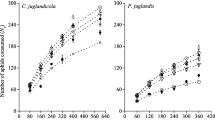Abstract
The present work aimed to study the effects of high constant and alternating temperatures on the development and prey consumption by Dicyphus tamaninii Wagner (Het., Miridae) with Aphis gossypii Glover (Hom., Aphididae) as prey.Results showed that the predator was able to successfully develop and reach the adult stage, on average, after 20.1 (♀♀) and 20.6 (♂♂) days at a temperature of 30 ± 1 °C with A. gossypii as prey. On the other hand, it was not able to develop at 35 ± 1 °C, here all N1 instars used at the beginning of the experiments had died even before moulting to N2 instar. At alternating temperatures of 25/15 ± 1 °C, the predator reached the adult stage 23.7 (♀♀) and 23.5 (♂♂) days after egg hatching, whereas when the temperatures were increased to 35/22 ± 1 °C, it took a significantly shorter period: 20.6 (♀♀) and 20.9 (♂♂) days. In general, the highest mortality occurred during the first two nymphal instars. The total percentage mortality during development from N1 to adult stage was 30 % and 100 % at the constant temperatures 30 ± 1 °C and 35 ± 1 °C, respectively. At the alternating temperatures of 25/15 ± 1 °C, it was lowest with 16.5 %, while at 35/22 ± 1 °C, it was 20 %.The results of the experiments on prey consumption showed that an individual D. tamaninii consumed during its development to adult stage at 30 ± 1 °C an average of 442.2 (♀♀), 433.6 (♂♂) aphids. At the constant temperature of 35 ± 1 °C, the average daily prey consumption started with 4 aphids and decreased continuously till it approached nil on the 9th day, where all predatory nymphs died. At the alternating temperatures of 25/15 ± 1 °C, the total prey consumption during development was, on average, 359.3 (♀♀) and 297.0 (♂♂) aphids, while at 35/22 ± 1 °C it was 348.5 (♀♀) and 334.0 (♂♂) aphids. The effect of the four temperatures on the prey consumption by D. tamaninii during the first 10 days after emergence was also studied. At a constant temperature of 30 ± 1 °C, a total of 446.4 (♀♀) and 372.0 (♂♂) aphids were consumed, compared to 40.6 (♀♀) and 39.0 (♂♂) at 35 ± 1 °C. At alternating temperatures of 25/15 ± 1 °C, the predatory adult consumed, on average, a total of 267.0 (♀♀) and 207.0 (♂♂) aphids. Increasing the temperature to 35/22 ± 1 °C resulted in a higher prey consumption by the adult predator, reaching 351.5 (♀♀) and 267.7 (♂♂) aphids over the same period.In conclusion, results indicated that D. tamaninii is a promising predator of the melon aphid at a temperature spectrum ranging from 15 ± 1 °C up to 35 ± 1 °C.
Similar content being viewed by others
Author information
Authors and Affiliations
Corresponding author
Rights and permissions
About this article
Cite this article
Saleh, A., Sengonca, C. Effects of different high constant and alternating temperatures on the development and prey consumption of Dicyphus tamaninii Wagner (Heteroptera, Miridae) with Aphis gossypii Glover (Homoptera, Aphididae) as prey. AFS 76, 118–123 (2003). https://doi.org/10.1007/s10340-003-0004-7
Issue Date:
DOI: https://doi.org/10.1007/s10340-003-0004-7




